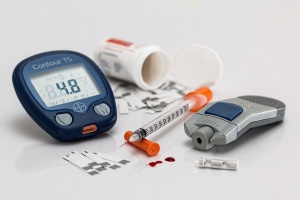Pharmacological Management of Diabetes Mellitus
Introduction[edit | edit source]
Diabetes (a chronic disease) can be managed effectively with lifestyle modifications (eg losing weight, diet and exercise) and use of pharmacological agents.[1]
Having an understanding of these medicines will allow physical therapists to identify medical emergencies, better manage treatment sessions, properly educate patients, and refer to the proper healthcare provider when warranted.
Commonly Used Medications[edit | edit source]
Insulin[edit | edit source]
Insulin is a hormone made by beta cells in the pancreas. When we eat, insulin is released into the blood stream where it helps to move glucose from the food we have eaten into cells to be used as energy.
- With type 1 diabetes, the body produces little or no insulin as the cells that produce insulin have been destroyed by an autoimmune reaction in the body. Insulin replacement by daily injections is required.
- With type 2 diabetes the body produces insulin but the insulin does not work as well as it should (referred to as insulin resistance). To compensate the body makes more but eventually cannot make enough to keep the balance right. Lifestyle changes can delay the need for tablets and/or insulin to stabilise blood glucose levels. When insulin is required, it is important to understand that this is just the natural progression of the condition.[2]
Pramlintide[edit | edit source]
Metformin[edit | edit source]
Sulfonylureas[edit | edit source]
Conclusion[edit | edit source]
The treatment of diabetes is dictated by the specific pathophysiology of the diagnosis. Regardless of the specific etiology, it is imperative for a physical therapist to be aware of the intended effects, as well as possible side effects, eg hypoglycemia and ketoacidosis, that may be prevalent with certain medications.
- Maintaining proper glucose levels can prevent sequelae of the disease, and can also impact the treatment session.
- Physical therapists are in a unique position because of the amount of time we spend with patients, and it is imperative that we play a role in monitoring their well-being.
References[edit | edit source]
- ↑ Ngugi MP, Njagi JM, Kibiti CM, Miriti PM. Pharmacological Managemen t of Diabetes Mellitus. Asian Journal of Biochemical and Pharmaceutical Research. 2012;2:375-81. Available:https://www.researchgate.net/publication/270282424_Pharmacological_Management_of_Diabetes_Mellitus (accessed 22.1.2023)
- ↑ Insulin







